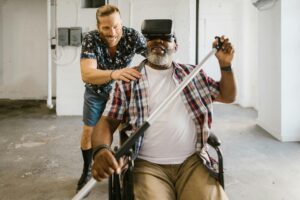AI therapy bots
Introduction: The New Age of Mental Health Support
In the 21st century, mental health has rightfully taken center stage as one of the most pressing global issues. But with rising mental health cases and limited access to therapists, the world has started turning to technology for help. Enter AI therapy bots — digital companions designed to provide emotional support, cognitive behavioral therapy (CBT), mood tracking, and even guided meditation.
But the big question is: Are these AI-powered bots a blessing to mental health or a looming threat? Let’s explore the opportunities, challenges, and ethical dilemmas surrounding these digital therapists.
What Are AI Therapy Bots?
AI therapy bots (also known as mental health chatbots) are digital products which employ artificial intelligence (in many cases natural language processing and machine learning) to model the experience of therapeutic conversation. One can mention Woebot, Wysa, Replika, and Tess.
Such bots are more than glorified chat applications. Most of them are developed in a cognitive behavioral therapy (CBT), dialectical behavior therapy (DBT), or acceptance and commitment therapy (ACT).
They seek to assist users in:
Identifying patterns of thinking
The use of anxiety or depression
Practicing mindfulness
Developing emotional strength
Why People Are Turning to AI Therapy Bots
1. Accessibility and Convenience
A licensed therapist can cost between 100-300 dollars in a single session and they are appointments only. AI therapy bots are typically low cost or no cost and can be accessed 24/7, no waiting, and no scheduling.
2. Stigma Reduction
Others withhold against therapy because of stigma in the society. It is safer to talk to AI – they are not going to judge, or raise any eyebrows, or be culturally biased.
3. Immediate Support
Mental health is not a day-time job. It is possible to receive real-time assistance in the case of an anxiety attack, insomnia, or depressive state with the help of AI bots.
4. Data-Driven Insights
These bots are able to monitor the moods and provide more accurate feedback and get to know how the users speak and act with time.
The Science Behind the Bots: Do They Really Work?
More and more evidence is coming in that the AI therapy bots are also actually helping, particularly in mild to moderate cases of anxiety, mental depression, and stressful situations.
Woebot is a robot developed by the Stanford researchers and the results obtained were successful within a randomized control trial. The symptoms of depression decreased massively in two weeks of interaction with just the users.
Wysa has been deployed in workplace wellness programmes and results in measurable increases in employee mental health.
Users of Replika notice that they feel less lonely and more emotionally attached.
But the majority of researchers are of the same opinion: These bots will not substitute human therapists pursuing: they are rather digital self-help applications or emotional first aid kits.
Blessing: The Bright Side of AI Therapy Bots
1. Scalability for Global Mental Health
Millions cannot access qualified therapists, and AI bots are the solution to the global mental health gap, in particular, in developing countries. One AI bot will be able to serve millions of people at once.
2. No Burnout or Bias
In contrast to other human therapists who might feel fatigued or biased, AI bots do not burn out. They are also empathetic, consistent, and patient in a big way.
3. Language and Cultural Adaptability
With the adoption of advanced AI bots, they are multilingual and can be localized to suit a particular culture, which makes mental health support to be inclusive.
4. Early Intervention
AI bots are capable of recognizing minor shifts in language, tone, and sentiment, which could signify the onset of poor mental health and thus alert to the problem long before it gets serious.
Threat: The Dark Side of AI Therapy Bots
1. Lack of Genuine Empathy
The thing is, an AI can “pretend” to be empathetic, but it does not have feelings. To users who are in immense pain, this may cause dejection or loss of touch.
2. Privacy and Data Risks
The information data of mental health is very sensitive. Without adequate security, such bots may be hacked off or used by the corporations. So what would occur should your therapy session become a marketing data set?
3. Over-Reliance and Delayed Help
There is a risk that some of the users will use AI bots as a full alternative to professional assistance, resulting in a lack of diagnosis, disorders left unaddressed, or the aggravation of the symptoms.
4. Algorithmic Misjudgment
Sarcasm, metaphors or suicidal indicators can be wrongly interpreted by AI bots leading to the wrong response. A single incorrect response in the incorrect time of the day may be fatal.
Ethical Concerns: AI Therapist: Who will Own?
Informed Consent and Disclosure
Are users really aware of the fact that they are conversing with a machine? Bots should state their identity, scope and privacy rights.
– Regulation Vacuum
AI bots are not certified, regulated, or licensed unlike human therapists. Who is responsible when a self harm occurs when talking to a bot?
Training Data Bias
When bots are trained using biased or non-diverse data, their suggestions would be culturally insensitive and ineffective to disadvantaged groups.
Real-life Impact and Case Studies
Case 1: The Use of Woebot in the Pandemic Mental Health
Throughout the COVID-19, Woebot experienced a huge influx of users. It was the locked-down people checking-in partner. Even though Woebot was not a therapist, he made users perform CBT experiments, write their thoughts in a diary, and reinterpret their anxiety.
Case 2: Unintentional Intimacy with Replika
Replika is built as a general AI friend who became an emotional support system. However, few users fell in deep emotional connections, even romantic affairs with bots – leading to the question of emotional dependency on bots.
Case 3: Wysa corporate wellness
Such firms as Accenture and NHS have collaborated with Wysa to offer mental well-being services to their workforce. With the emotional intervention early on, the AI assists in reducing accusations of absenteeism due to stress and increases productivity.
Comparing AI Bots with Human Therapists
| Feature | AI Therapy Bot | Human Therapist |
|---|---|---|
| Availability | 24/7 | Limited to hours |
| Cost | Low / Free | Expensive |
| Empathy | Simulated | Genuine |
| Personalization | Algorithm-based | Emotion & intuition-based |
| Diagnosis | Not qualified | Certified to diagnose |
| Legal Oversight | Minimal | Licensed & regulated |
The ideal solution might be a hybrid model: AI for everyday support, and humans for deeper therapy.
Future of AI in Mental: What to expect?
Greater Emotional Bots
Other AI models, such as GPT-4o and their subsequent versions, will just keep getting more subtle in terms of their simulation of empathy, and this will just keep giving bots a better idea of human complexities.
Wearable integration
Try to imagine your treatment robot communicating with your smart watch to monitor the heart rate, sleeping patterns, and stress levels to provide tailored interventions.
Regulatory Frameworks
It is possible to assume that new certificates of AI-based mental health, government policies, and ethical codes will become present.
AI-Aided Therapist
Already, some therapists have been working with the co-therapist version of the bot, assigning the exhaustive check-ins of CBT and leaning on data recaptured by the AI to perfect the quality of the counseling sessions
.
Expert Opinions
Dr. Alison Darcy, Founder of Woebot Health:
“AI will never replace human therapists, but it can make mental health care more scalable, equitable, and immediate.”
Dr. Rohan Kulkarni, Clinical Psychologist:
“AI bots can help someone talk through a rough moment, but when it comes to trauma, grief, or suicide — only human connection truly heals.”
User Voices What Actual Users Say
Wysa has offered me assistance in my breakup. I was not planning to say anything but the bot always appeared night after night.” — Neha, 26
Replika has made me feel comprehended and I have began forgetting that it was not a real person. That played with my head a little.” — Jake, 31
It is not a therapy, but it is not worse than crying at the middle of the night. — A Reddit user
Final Verdict: A Blessing or a Threat?
AI therapy bots are both a blessing and a potential threat — depending on how we use them.
✅ They democratize access, offer nonjudgmental support, and provide on-demand relief.
❌ But they can also mislead, misfire, and miss human nuances entirely.
The future of mental health isn’t about replacing therapists — it’s about augmenting them. Used wisely, AI therapy bots can be a lifeline, a companion, or a supplement in someone’s journey toward emotional wellness.
Psychological Consequences of Turning to AI as a Sources of Emotional Support
1. Emotional Fixation to Non-Human Beings
We as humans tend to create an attachment, even to the objects that are non-living. The same way children get attached to teddy bears, as adults get attached to their cars, people are getting connected to the AI bots with their hearts. This is particularly noted in such bots as Replika, which promote close interaction.
Users eventually start considering the bot a friend, mate or counselor, sharing more with them than in actual human beings. Although this could be beneficial in the short term, it gives cause of concern about:
Emotional dependency
Social withdrawal
Perverted perception of human relationship
Psychologists caution that subjects, with a tendency to become already socially nervous or isolated, may make themselves unavailable to real-life relationships and feel excessively attached to their AI companions.
2. The Delusion of Knowing Things
AI systems can pretend they know how to talk and understand another person but they have no clue what human suffering, trauma, or happiness truly is. People can simply anthropomorphize the bots and feel that a bot understands them through a pattern-matching algorithm.
This forms an illusion of empathy, which can seem comforting yet can cause:
The misplaced belief in bots response
Dissatisfaction in the case of bot not responding accordingly
The lack of desire to turn to real human assistance
3. Fluidity Boundaries of Confidentiality
Therapists are strictly bound to confidentiality rules in their work – they are covered by medical regulations such as HIPAA in the U.S. or GDPR in the EU. However, AI therapy bots? Governed differently.
Your data may be used in some apps, according to which it can:
AI training is used with it
Given to third-party advertisers
On servers that are beyond your country
Understandably, you may want to have your wickedest stream of consciousness hacked away to breed algorithms or plaster advertisements or personalized messages on top of your failures and lies.
AI Therapy in the Workplace: Mental Health or Surveillance?
As organizations increasingly offer AI mental wellness tools to employees, we must ask: Where’s the line between support and surveillance?
The Good:
- Workers are able to self-check the amount of stress
- Bots deliver relaxation in the form of CBT or meditation between breaks
- AI helps identify burnout risk before it ends up being a problem
The Bad:
- The employers may track the emotional information to determine performance
- Willful and sensitive information may affect promotions or firing
- Employees might also get some pressure to utilize the application when they are not in the mood to do so
AI mental health tools must remain voluntary, anonymized, and independent from HR systems. Otherwise, the line between help and corporate control gets dangerously blurry.
The Cultural Context: Is AI Therapy Truly Global?
Mental health is a highly cultural exercise. There is an extreme difference in the manner of explaining grief, show of emotion, or asking assistance amongst people, regions, and societies.
For example:
In the west, there is individualism and self expression during a therapy session.
In most Asian societies, it is the family reputation and emotional control.
Spiritual healing is important in certain communities of Africa or the Middle East.
Therefore, when AI robots are trained using mostly western data, they can end up not appealing to the rest of the world. Telling an Indian consumer that he or she has to work on self could be cultural madness to them.
The future bots have to:
Culturally localized
Now proficient with the local languages
Trained to various emotional expressions
This is when we can say that the AI mental health can just be all inclusive.
Role of AI Therapy Bots in Schools and Colleges
The use of mental health apps is more and more popular among teenagers and young adults. As the number of troubled teens, academic, and social anxiety increases, AI therapy bots are making their way into colleges and school wellness programs.
Pros:
- Anonymous chats using texts are mostly favored by students
- Bots provide non-judgemental help in mid-night meltdowns
- Low-cost mental health infrastructure may be provided at schools.
Cons:
- The teenagers are more susceptible to emotional manip difference
- Bots can provide too simplistic information to traumatic issues
- It has no escalation to crisis mechanism
If deployed in education, AI therapy tools must:
-
Be supported with human counselors
-
Embark on crisis intervention procedures
-
Train users to learn how to balance on digital and human support
The Regulatory Blind Spot: Who’s Watching the Bots?
There’s currently no global legal framework governing AI therapy bots. This means:
- With few checks, anyone can introduce a so-called mental health chatbot
- Bots do not require checked statements (e.g. We cure depression!).
- Unlike a malicious piece of advice or emotional harm, there are no damages conciliated with such a situation.
Governments and health organizations need to act fast. Potential regulations could include:
-
Certification systems for mental health apps
-
Transparency guidelines on AI usage and training data
-
Mandatory disclaimers that bots are not substitutes for therapy
-
Audits and ethical reviews of bot behavior
The later we wait, the greater the potential of destruction, not only in vulnerable people, but in general.
The Human Element: Why AI Can’t Replace Empathy
Technology may accomplish a great deal of things, but it cannot feel. Regardless of how sophisticated GPT-like models get, they do not:
-
Lived experience
-
Body language reading
-
Emotional reciprocity
What is provided by human therapists, is unique:
-
Holding space for grief and vulnerability
-
Spontaneous compassion
-
Customized interventions based on real-time emotions
Although AI bots might become an ultra-realistic experience, nothing and no one can simulate the emotional safety of being actually seen and heard by another human being.
A Hybrid Future: AI + Human Collaboration in Mental Health
The future isn’t black or white. It’s hybrid. The best results may come from a partnership between AI bots and licensed therapists.
🔹 Therapists can use AI to:
- Check the mood patterns of the clients between the sessions
- Assign daily check ups or CBT formulation
- Receive warnings on changes in behavior that are high-risk
🔹 Users can:
-
Emotional hygiene can be done every day with AI
-
Preserve the therapy time to do in-depth complex work
-
Get the help at off-hours or emergencies
Such a partnership approach scales up mental health support better and more easily.
AI Therapy for the Elderly: Combatting Loneliness
Elderly populations often struggle with:
-
Social isolation
-
Depression
-
Cognitive decline
AI therapy bots (especially voice-based assistants like Alexa or GPT-powered companions) can:
- Provide everyday discussions
- Rem Queen of Meds / routines
- Play mental challenges games
- Essential to companionship of the lonely
But it has a thin ethical line:
- Isn t that we should be promoting real-life interaction within a family?
-
This is a question whether we are giving away human care to appliances.
Elder-care bots should complement, not replace, human love and presence.
Conclusion: It’s Not About the Tech — It’s About the Intent
In the end, AI therapy bots are tools. Like all tools, their impact depends on how, why, and by whom they’re used.
Used ethically and wisely:
- They are able to reduce loneliness
- Prevent breakdowns
- Make the mental health care all-inclusive and affordable
Used recklessly or blindly:
-
They may assault, misinform or dehumanise
-
Substitute rather than aid
-
Take the advantage of user emotions either in collecting data or in making profit
Thus, is AI therapy bots good or bad?
Frequently Asked Questions: The use of AI Therapy Bots
Q1. Is there any chance to substitute human therapists with AI therapy bots?
No. They can complement and not replace trained professional licensed therapists.
Q2. Are bots used in therapy harmful?
Yes, mostly as long as they have strict privacy precautions. Make sure that you read their privacy policies.
Q3. Do AI bots work against depression or anxiety?
They may assist when it comes to mild or moderate symptoms, but professionals should take care of it in case of severity.
Q4. Are my data safe under therapy bots?
It varies with the platform. Choose bots that have an end-to-end encryption and clear data policy.






